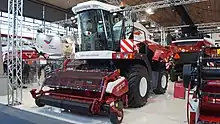Rostselmash
Rostselmash (Russian: Ростсельмаш) is a Russian agricultural equipment company, based in Rostov-on-Don. It was founded in 1929. It primarily produces combine harvesters. The company income in 2005 was 400 million dollars. It used to sponsor a football club that used to be called FC Rostselmash and is, as of 2008, called FC Rostov.
Native name | Ростсельмаш |
|---|---|
| Founded | 1929 |
| Headquarters | , |
Key people | Konstantin Babkin, Dmitry Udras, Yuri Ryazanov, Valery Maltsev (CEO) |
| Revenue | $700 million[1] (2017) |
| $24.9 million[1] (2017) | |
| $223 million[1] (2017) | |
| Total assets | $610 million[1] (2017) |
| Total equity | $472 million[1] (2017) |
Number of employees | 9,462[2] (2016) |
| Website | en |
The company name is a syllabic abbreviation of Rostovskiy zavod sel'skokhozyaystvennykh mashin (Russian: Ростовский завод сельскохозяйственных машин), the Rostov factory for agricultural machines.
History
Rostselmash was founded in 1929 as a government contractor, producing a variety of products for state farms. In 1931, the first Stalinets harvesters were produced. The Stalinets-1 was awarded with the highest award (Grand Prix diploma) during the World Industrial Exhibition in Paris in 1937 and by 1940 fifty thousand units were assembled.
During Operation Barbarosa, Rostselmash dismantled its plant in Rostov-on-Don, and relocated in Tashkent, the capital of Uzbekistan. Production shifted from agricultural goods to military equipment until the end of the war. In 1943, production was returned to Rostov.
After the war, the Stalinets-6 harvesters were assembled and in 1955 Rostselmash began to specialize in grain harvester production. In 1958, the SK-3 self-propelled harvesters were introduced followed by the SK-4 in 1962. By 1969, Rostselmash produced 1 000 000 harvesters. The SK Niva harvesters, introduced in 1973, remain in production for the Eastern European market.
By 1984 Rostselmash produced 2 000 000 harvesters. The Don Series combines were introduced in 1986; those along with tractors were sold in North America by Belarus Tractor of Canada. Both had a reputation for poor quality, lack of operator comfort, poor reliability, and lack of part availability.
After the fall of the Soviet Union, Rostselmash was incorporated into a joint-stock company in 1992, and fully privatized in 2000. The new owners — Konstantin Babkin, Dmitry Udras and Yuri Ryazanov withdrew Rostselmash from the crisis of 1990-s.[3]
— The Economist, 8.11.2018.[4]
In 2007 they took control of Buhler Industries of Winnipeg in Canada.[5] Buhler Industries are the owners of the Canadian–built Versatile brand of articulated tractor, founded by Peter Pakosh.[6]
Products

Harvesters
Rostselmash produces four harvester variants. A 400 hp rotary harvester is sold the Rostselmash name in Eastern Europe and the Versatile name in North America. The RT 490 uses a unique Rotating Concave Rotary design where the concave rotates counter to the rotor, reducing dead spots and increasing usable area.
Vector and Acros harvesters are sold in North America through Python Manufacturing Inc.
The Niva is a 155 hp harvester developed in the Soviet era, and is available only in Eastern Europe and Africa.
Tractors
Versatile tractors are available from 190 to 620 hp.
References
- "Бухгалтерская отчётность". Retrieved 1 November 2018.
- http://www.rbc.ru/companies/id/184.
- Igor Burakov. Large harvest // Forbes, 03.08.2004 (in Russian)
- From the article «We move to Russia in our series on Europe's second-tier cities» // The Economist, 8.11.2018
- Buhler Industries Inc (BUI.TO) // "Reuters".
- Pakosh, Jarrod. Versatile Tractors: A Farm Boy's Dream. Boston Mills Press. ISBN 978-1550464160.
External links
 Media related to Rostselmash at Wikimedia Commons
Media related to Rostselmash at Wikimedia Commons- Official website
